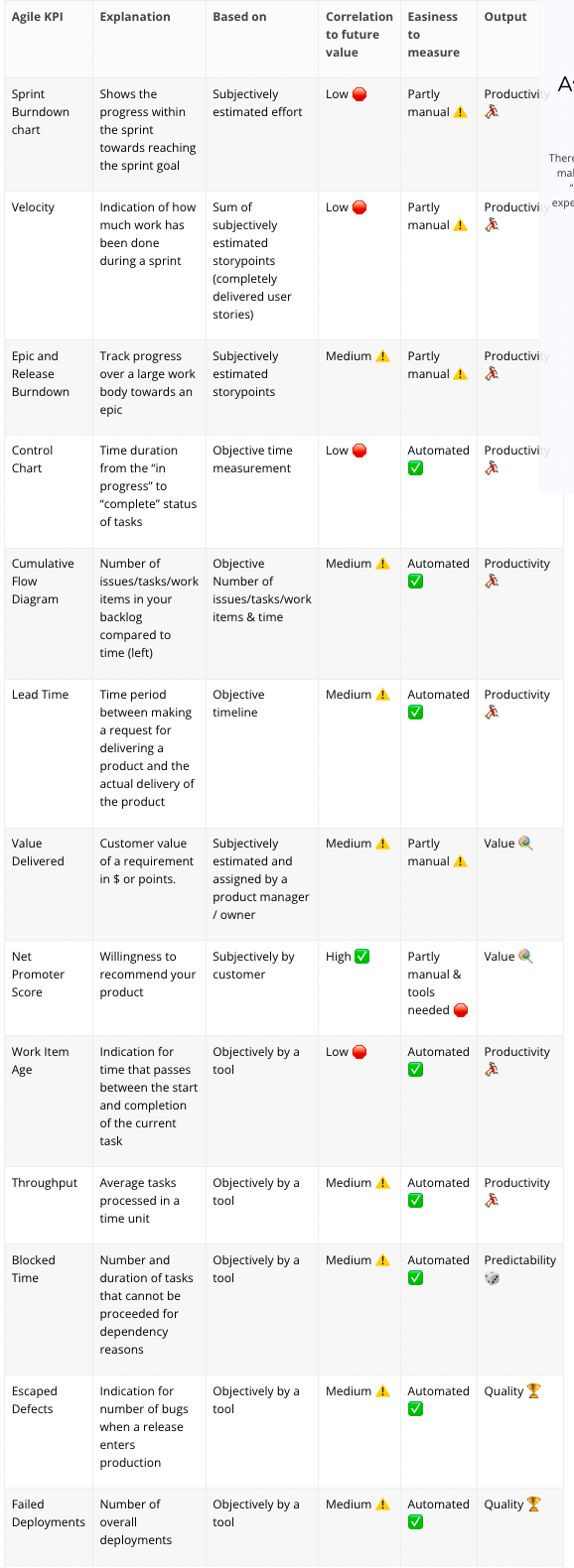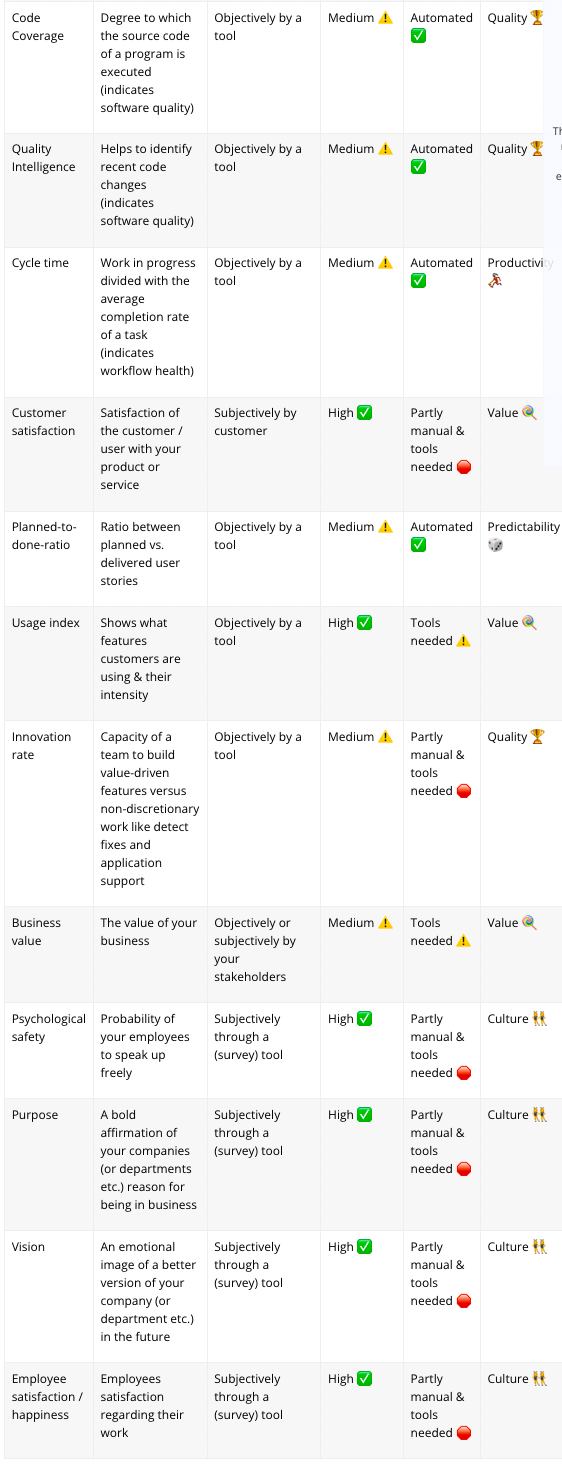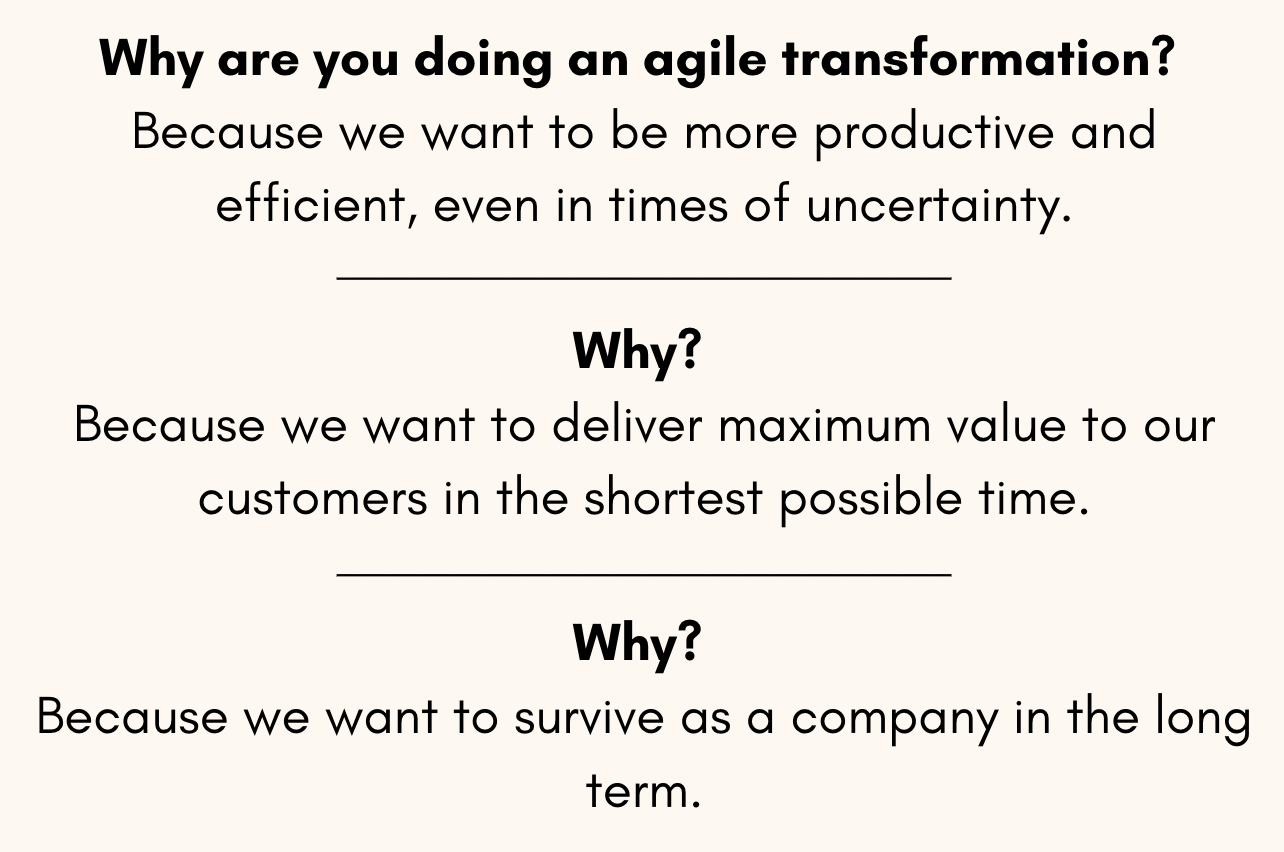You and I know it: There are loads of agile key performance indicators, metrics and measurements. But you always have to keep one thing in mind:
“Tell me how you measure me, and I will tell you how I will behave.”
Dr. Eli Goldratt
Therefore, one question has to be asked: Are all of these metrics relevant? And then there is this other citation:
“Simplicity is the soul of efficiency.”
Austin Freeman
So the next question arises: If we would want to measure agile as simply as possible, how would we measure it? What agile key performance indicators, metrics and measurements matter most? Or if we would measure only one damn thing, what would it be?


Don’t get me wrong: Of course you can have more complicated models for agile key performance indicators or metrics, such as the Agilometer. But I was fascinated by the goal to measure one thing only. Therefore, this article investigates this goal.
The above agile KPIs serve as the basis for this text.
Before we go any deeper, a quick note. We will soon hold a free webinar on the topic of "the best agile metrics" – with 11 international experts as our guests! You can find more information about it in the teaser video below.
If that sounds interesting, check out the Project Scagile website for more information - you can also register there (see red button above).
Do we even want agile key performance indicators, metrics and measurements?
Before we go deeper, one thing that I regularly hear or read on LinkedIn when I talk to agile coaches, scrum masters or scaled agile frameworks consultants: Do you even want to measure agile?
“There are lies, there are damn lies and then there are statistics.”
Mark Twain
Mark Twain is a little dramatic about it. But he has a point. A point that Albert Einstein put in a Nutshell.
Not everything that counts can be counted, and not everything that can be counted counts.
Albert Einstein
What is "KPIs" in agile - Velocity, Burndown charts, number of failed deployments? Are these metrics key for agile success? I doubt that.
But abandon all metrics? That would also be a mistake.
In today’s world, economical circumstances change fast. In good times, decision makers start thinking about an agile transformation because they have the resources and safety to do so. And in bad times?
In bad times, senior executives will fall back into traditional thinking. They will move to old behavioral patterns: e.g., top down decisions that are not compatible with modern agile thinking.
Most Agile Coaches and Scrum Masters run in circles...
...fixing superficial symptoms. Time to use psychology to foster sustainable mindset change.
If you would accept not having agile key performance indicators in bad times, you shouldn’t even start an agile transformation. Because at that point, any progress made within that transformation would be destroyed.
Therefore, the only chance that scaled agile frameworks survive difficult times is by beating the system with its own weapons: by providing metrics. Agile key performance indicators that help to manage in times of uncertainty.
And I am sure about it: there are agile metrics that matter.
“In retrospect, I consider it one of my biggest mistakes to have always categorically rejected metrics for the agile transformation.”
Marcus Raitner
Einstein also says it in his citation: There are things that count. Those are the ones we are looking for in this article.
Agile key performance indicators, metrics and measurements - What makes a good metric?
Let’s say, the question you ask in your daily stand-up typically is: What did you achieve today? This is, therefore, how you “measure” progress in your team.
Good question, right? No, not right. This question makes you want to show you are busy. It pressures you to get your “To do list” done, so that you can proudly update on your metric: Yes, I was very busy in the last 24 hours!
Getting your “To do list” done, is good, is it not? Well, it depends. Far more important is something else: reaching your goal. This is typically - in case of agile teams - delivering value to your customers.
Agile KPIs - how to measure agile success
Therefore, a better question (or metric) within your Daily Stand-up would be: “How did I help my team or organization achieve our (sprint) goal in the last 24 hours?”
Change the question (or the metric), change how people think and act: effective first, efficient second - to use the words of Peter Drucker. Peter Drucker accept.
Change the metric, change how people think and act.
To use Einstein’s wording, we have to find the one thing (if we want to measure one thing) that can be counted - and that really counts.
What does really count in an agile transformation?
How agile metrics and measurements should be viewed
The goal of your agile transformation is definitely not an agile transformation. Why do you do the agile transformation? Let’s try a “3-why’s technique” to understand that.

So the core reason for your agile transformation: you don’t want to end up like Blockbuster, ignoring industry trends and customer needs, unopen to change and finally running out of money.
You want to end up like Netflix, who are constantly evolving their business model around their customers' core needs. Just look at them Case Study Blockbuster vs. Netflix.
How can you translate that into measuring one thing in an agile transformation? Well that’s tough.
What companies do instead: measuring parameters because they are easy to track. Because tools out there throw them at you. The probability that these are the right metrics is pretty low.
Because for example, it is not about improving sprint velocity. That is a common mistake: monitoring and measuring effort, or efficiency. Instead, it is about solving customer needs.
Agile metrics that matter - a key takeaway
Having laid down all of this, if we want to measure one thing in agile, we have to rate the validity of this metric against one thing.
We need to measure outcomes, not outputs. We have to measure our agile transformation by how much it helps us to achieve our goal. We do not have to measure people by the time they spend, but by their contribution to a common vision or a common goal. We have to measure people by the benefit that has been created for the customer!
If we want to measure by value, we have to deeply understand the customer’s needs.
For example, a railroad company has to understand that it is not in the railroad business. It has to understand that it is in the transportation business. Customers do not care if they are transported by train or by plane.
One other thing: Of course, it is key to not only measure but also reflect on agile metrics. Like for example about the Spotify Health Check´ results (through a retrospective).
You can use our Echometer Health Check & Retro Tool to do exactly that (even across teams). You can find more information on this on our "How it Works" page. You can also just open a Health Check Retro here. In this case it's a health check retro on Scrum.
Note: This retrospective format asks for agreement with the given Health Check items on a scale.
- Planning: Backlog refinement in our team is efficient and effective.
- Customer orientation: The planning of our sprints is always based on achieving the greatest possible customer benefit in the given time.
- Agile education: Team members, Product Owner and Scrum Master share the same understanding of their respective roles in the team.
- Scrum Events: Lately, every Daily in our team has paid off.
One other thing about agile metrics that matter - timing
One other thought is important here. At best, metrics depend on the timing and/or at what stage you are in your agile transformation.
Let’s imagine that you already know that transforming to scaled agile frameworks or other agile working practices is the right move for you (That is by the way the first thing that many companies forget to check).
In that case, at the beginning of your agile transformation your focus should be on one thing: The agile mindset of the leadership team.
Is the leadership team really ready to change? Does it understand the implications of a transformation? Is it ready to be the first team of the company to implement agile methods by heart - e.g., Kanban & transparency, agile retrospectives & continuous self reflection?
So, in theory, a first Agile metric should focus on “executive or leadership team readiness.” My colleague Jean gives in his article 7 tips on the role of leaders in agile transformations.
The next most important question to ask in your transformation: Do we have the right processes in place to understand and monitor our customers’ needs continuously? This is where the next agile metric could focus on.
But stop. This does not help us reach the goal of this text - to measure one thing. one Thing to measure.
No. It serves to inspire you for your agile transformation.
So let's take a look at what typical agile metrics exist and to what extent they correlate with the most important outcome that your agile transformation is about: customer benefit.
Agile metrics that matter - a ranking
You can find a table above with the agile metrics that matterwithin scaled agile frameworks and agile transformations. I ordered them by five areas, five goals that you generally want to reach through your agile transformation:
- Customer value: Are you meeting the customer’s needs?
- Predictability: Are you delivering on time with smooth processes?
- Productivity: Are you getting more and more done at the same time and with the same resources?
- Quality: Do you deliver a product free of bugs and other issues?
- Culture: Are the people in your organization satisfied, continuously learning and do they feel free to innovate, making sure you can maintain your pace?
Agile KPIs - how to measure agile success
The table above also gives an indication of
- how easy it is to measure the metric (based on my personal experience)
- how much that metric is correlated to our core goal with a long term perspective: future customer value (based on my experience).
So which agile metric from the table above is the one?
Interesting to note is that there does not seem to be an agile metric that is easy to measure and provides the right kind of value. Damn it.
I would say that the “Easiness to measure” is not as important as “Correlation to future value”. Therefore, the most valid metrics seem to be “Usage Index”, “Customer Satisfaction” or the “Net Promoter Score”.
By the way, talking about agile transformation... one quick hint: Do you want to make sure that you are setting the right priorities in your agile transformation ?
Then do our maturity check for your agile transformation – only takes 3 minutes. You even get a benchmark based on over three hundred other participants. See button
Scaled agile framework - Measure one thing!
It does not matter if you use the Scaled Agile Framework (SAFe®) to measure one thing, or a different framework to do your agile transformation.
Given these three agile key performance indicators, what correlates most with future customer value is probably customer satisfaction. Or, to be more specific, top-box customer satisfaction. You can find more on that topic following this link.
Customer satisfaction probably also has the highest correlation of all of these metrics with the ROI of your agile transformation. It shows you whether to pivot, persevere or perish.
Scaled agile framework - Really measure one thing?
But stop. By focussing only on customer satisfaction, how do you make sure you are staying ahead of your competitors long term ? How do you make it possible that innovative and disruptive ideas can flourish in your company? Which is your long term goal...
Given these questions, I think we are getting back to the basics: to continuously provide value and to innovate around it, you need two other things: smooth agile processes and a great company culture.
Your company culture makes sure that employees feel psychologically safe , are open to fail, raise their voice and share their ideas. And your agile processes make sure you implement these ideas faster than your competitors.
Agile, like a leader, aims at people-first approach; putting people above things.
Vikram Verma
The following graphic illustrates this in an easy way. If value is your long term goal, then our input is your working methods times culture.
I once read once read that "Agile transformation requires culture change, not process change.”
I disagree with that. It requires both.
Scaled agile framework - Measure one thing? Measure three things!
In conclusion, if you only want to measure one thing in the Scaled Agile Framework (SAFe®) or other frameworks, yes, it could be "cost of delay" (that is the official version, according to the SAFe® test). But from my perspective, easier to implement is measuring customer value. It is the agile KPI to measure agile success. But I cannot recommend measuring only one thing - sorry for disappointing you.
If you really want to keep it as simple as possible with your agile key performance indicators and metrics, I recommend that you measure a minimum of three things that will help you thrive long term:
- Measure customer value - through customer satisfaction.
- Measure Corporate culture - through psychological safety as an indicator for learning and innovation.
- Measure agile effectiveness - through planned-to-done-ratio as an indicator for how well you are able to incrementally deliver value.
After measuring, build. Then learn. And then iterate on your metrics...
That’s so easy, right? Nope. Are you serious about implementing agile frameworks throughout your department or company?
What is a good KPI in agile and can I do about it?
We recently interviewed dozens of experts - release train engineers, agile coaches, Scaled Agile Framework consultants - around agile key performance indicators and metrics in scaled agile frameworks and agile methods in general.
Based on those interviews, we developed Project Scagile: 7 webinars to help you avoid the 7 core mistakes in agile transformations . One of the webinars is on Agile Metrics - so you better check it out.
By the way, if you are still looking for a suitable retro board, our article can help you with the topic: Comparing the 6 best retrospective boards










